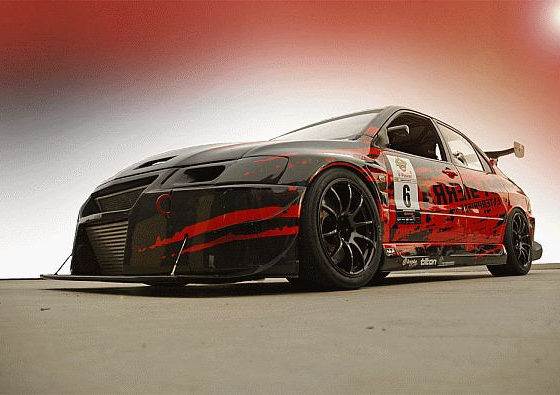,
Making it handle
The next two races were less successful, with chain failures, brake fires, self-shifting transmissions, AWOL connecting rods, and midnight, mid-race engine rebuilds. The development work that happened over these ill-fated events deserves a page to itself, though. Peruse the photos for a lesson in dirtbag suspension engineering.
 |
||
| The first thing any front-drive shitbox needs to be a race car is a stiffer rear suspension. Stiffening the rear forces the rear tires to carry more of the cornering load, relieving the overworked front tires and reducing understeer. Not only was the back of the Metro softly sprung, it didn’t even have a rear sway bar. The heavier 4-door Metros had a rear sway bar, though. They also had somethign to bolt them to. Since the 2-door lacks the sway bar mounts, Alex welded this crossmember into the spare tire well. |
 |
||
| With the right attitude, half price day at the junnkyard is also 2 for 1 day. Two 4-door Metro sway bars are attached by simply welding two stock sway bar brackets back to back. |
 |
||
|
While you’re under here, though, look around a bit. That rear spring doesn’t seem to fit right… That’s because its actually a rear spring from a 1999 BMW M-Coupe. Alex’s street car wears lowering springs, so these were just laying around. And no, they don’t actually fit. By some miraculous coincidence, the car sits at a reasonable ride height, but the bottom of the spring sits up on the hump that’s supposed to center the stock spring. At full droop the BMW spring will simply fall out, so a steel cable is used as a droop strap to prevent a Felipe Massa moment. The steel plate welded to th end of the toe control link is also worth noting. Looking for potential weaknesses, Alex bolted a 6′ bar to the hub and pushed on it to see what flexed when the suspension was subjected to corenring loads. The end of the toe link flexed. Now it doesn’t. |
 |
Up front, the front springs are simply cut stock pieces. Anything substantially stiffer would simply overpower the feeble damping power of the stock Metro shocks. This simple tab of scrap steel holds the shortened spring to the perch so it doesn’t fall out at full droop. | |
 |
||
|
Those cut front springs are paired with a slightly stiffer front bar from a 4-door Metro, but that still wasn’t enough to quell the car’s massive body roll and constant bump-stop thumping. The sortof Honda-ish wheel and tire size worn by the Gnome is a larger overall diameter than the stock Metro. These big tires lift the car, and mask the fact that the suspension is actually sitting quite a bit lower than stock. Sitting so low puts the lower control arm at an awkward upward angle, putting the roll center too low and exacerbating the body roll problem If you haven’t spotted the solution yet, you haven’t spent enough time under Geo Metros. Notice the ball joint and the tie rod. The ball joint has been moved down, restoring the original conrtol arm angle. Doing this alone would cause horrendous bump steer as the tie rod and control arm swing through different arcs. To restore harmony, the tie rod was flipped. It normally attaches to the top of the steering arm. How was all this accomplished on a Lemons budget? Scroll down… |
 |
 |
|
|
The ball joint was moved first by pressing a 1/2″ pipe coupler (threaded on the inside) into the front upright’s ball joint clamp. The coupler was clamped in place, then tig welded to the forged steel upright. On the control arm, Alex used a 1″ hole saw to remove the old ball joint and welded in a spherical bearing with a 1/2″ ID. Now, a grade-8, 1/2″ bolt threads in to the pipe coupling from below, and spacers can be stacked between the pipe coupler and the spherical bearing, making the control arm angle adjustable.
|
|
Had I seen this before the race, I would have insisted there was no way a random pipe coupler would have the strength for this duty. I only spotted this mod after it had survived two races, though. That’s 28 hours of race time, plus countless hours of testing. A 1600-lb curb weight does give a certain design freedom… The tie rod flip was much simpler. The taper of the Metro’s tie rod happens to match that of a Volkswagen. Alex found this simple tie rod flip kit for sale, consisting of a drill bit to remove the existing taper from the steering arm, and a tapered insert to press in from below, letting the stock tie rod install upside-down. |
 |
||
| The fully developed dual-chain, sealed diff setup should have provided bulletproof reliability. Instead, it simply exposed the car’s next four of five weakest links. |
Though the car was working well on track, durability took a vacation at Buttonwillow. Practice day revealed a cracked engine case, which the team JB welded back together. During the race, the transmission went crazy, randomly shifting itself and shedding teeth. The car lurched into the pits and the team quicky swapped to a spare engine from another bike. Less than an hour later they were back on track, and less than half an hour after that, a connecting rod got island fever and decided to go see the world.
This still left enough parts to make a running car, but none were in the right place. Overnight, both engine cases were split, the gearbox from the second engine went into the first engine’s (cracked and JB welded) case, and the car was ready the second day. Hours of successful abuse followed, but in the end, entropy would have its revenge. One hour from the end, a horrible vibration warned of the disaster to come, but the team plugged their ears and pressed on.
30 minutes to go, and the vibration suddenly stopped. So did the front wheels, bringing the race to a screeching halt. The vibration started when the crack in the case finally propogated to the rear motor mount, snapping it off. The back of engine dropped, letting the slack side of the chain drag on the crossmember. The vibration eventually shook loose the nut holding the double-sprocket contraption to the bike’s output shaft. The chain dropped, swung around, hooked the crossmember, and stopped the party.
Fresh out of CBR900 engines, Alex immediately started planning to swap in the fuel injected CBR1000 engine hiding under his workbench. The detail work we’d already seen in this car suggested he had his head on straight enough that he would simply build on a reasonably sorted machine, sticking the enigne in the same location as the 900 and methodically working out the bugs. This was exacly what he said he would do as he left Buttonwillow.
When rumors of a rear-drive 1000-cc Gnome surfaced, we immediately assumed Alex had turned his clever streak from junkyard engineering to misinformation and rumormongering. Well played, we thought… We gave him too much credit. The rumors were true. Hit the next page for MetroGnome 2.0.


 At the ends, a simple homemade link connects both bars to the end link.
At the ends, a simple homemade link connects both bars to the end link.
